Questions asked by our customers; answered by Dara’s sommeliers
1. How do I pair my wine with food?
Pair like with like; sweet with sweet, sour with acid, rich food with powerful wines. Don’t just focus on the protein; pair with the most dominant flavor in the dish which is often the sauce. For example, a rich Chardonnay with smoked salmon and a butter sauce. Light sushi and a full-bodied Cabernet Sauvignon? not so much!
2. How long will wine last after the bottle has been opened?
White wines typically maintain their character and flavor for up to two nights after opening, while red wines may undergo structural changes after a day. However, this can be advantageous for young, tannic reds, as they might improve in taste by the second day. Dessert wines can remain enjoyable for a week or two after opening. But remember to close the bottle well or even better transfer the wine to a container with as little air as possible and store it in the fridge.
If you often find yourself with a few half-finished bottles opened at the same time maybe it is time to buy a CORAVIN Wine System. By inserting a medical grade needle through the cork and injecting 99.9% pure argon gas, the bottle is pressurized and wine is being pushed out. When finished, the needle is pulled out and the cork reseals due to its elasticity, no air has gone into the bottle and the remaining wine can be preserved and continue to age. You can also just buy a canister of argon gas that can be sprayed in the bottle before storing it which will accomplish a similar result.
3. What are the sediments in the wine? Has the wine gone bad?
Sediments in wine are natural, they consist of particles that precipitate out of the wine over time, typically composed of grape solids, yeast, or tartrates. Sediments are not an indication that the wine has gone bad. They are natural components that can form in aged wines, especially those that have not been filtered or fined extensively. While sediment may affect the wine's appearance, it does not affect its taste or safety. However, it's common practice to decant wine with sediments to separate them from the liquid before serving.
4. Should I decant?
Decanting wine is generally unnecessary at first, as wines benefit from aeration when poured into large glasses. If we decant first and then find that the wine lost some fruit to the air, there’s no going back. So it's advisable to taste the wine first to assess its need for decanting. Younger red wines with significant tannins can especially benefit from decanting.
5. How many bottles do I need if I’m hosting a party?
One regular bottle of wine equals about five glasses, so get enough so that your guests can have at least two glasses. (For example: If you have 10 guests, buy four bottles). Normally, party planners assume that guests will drink 2 glasses during the first hour, and then one glass for every subsequent hour. So, for a two-hour dinner party, that will be 3 glasses of wine per guest. When in doubt, it’s always a good idea to grab an extra bottle just in case; unlike that food, the wine will not go bad.
6. Does white or red wine have more alcohol?
Alcohol levels do indeed vary depending on the variety of grape. Red grape varieties generally contain more alcohol than white varieties. Light whites like Portuguese Vinho Verde can have as low as 9% alcohol while Chardonnay from Tuscany can have up to 14 percent. Lighter red wine styles typically contain 13 percent alcohol, while richer varieties exceed 14 percent.
7. Are Shiraz and Syrah the same?
Shiraz and Syrah are two names for the same grape variety. "Shiraz" is commonly used in the Southern Hemisphere such as Australia and South Africa favoring rich, fruit-forward wines, while "Syrah" is prevalent in French winemaking traditions. Interestingly, the grape variety’s origin hails from France (not Iran) and no one really knows how it became Shiraz when it was taken to Australia in the late 1800s.
8. What are tannins?
Tannins contribute to the astringent and dry sensation on the tongue often experienced with wines like Cabernet Sauvignon and Nebbiolo. They derive from grape skins, seeds, stems, and oak, intensifying with prolonged skin contact during fermentation. Comparable to the astringency found in tea or walnuts, tannins enhance wine structure and mouthfeel.
9. What is the difference between organic and natural wine?
Organic wine is made from grapes grown on organic farms without synthetic pesticides, herbicides, or fertilizers. It adheres to organic farming practices, regulated and certified by official organizations.
Natural wine goes beyond organic farming practices and emphasizes minimal intervention in the winemaking process. It typically involves using native yeast for fermentation, avoiding additives like sulfites, and employing non-industrial techniques. However, the term "natural wine" lacks definition, regulation and certification resulting in each winemaker interpreting the term as they see fit.
10. Why does wine give me headaches; sulfites, right?
Unlikely. Sulfites are added as preservatives and antioxidants (for example, to prevent browning) to a range of foodstuffs including dried fruit and vegetables, potato-based products, beer and malt beverages, wine, and fruit juices. Sulfur dioxide (SO2) protects wine from not only oxidation, but also from bacteria. Without sulfites, grape juice would quickly turn to vinegar. A small number of people experience an allergic reaction to sulfites (itching, respiratory constriction etc), but sulfites don’t cause headaches. Wine headaches causes are highly personal. It has to do with hydration, ability to metabolize alcohol, and histamines. Remember to drink plenty of water then you drink wine and if you experience severe headaches, it is really is best to consult your doctor about this.





